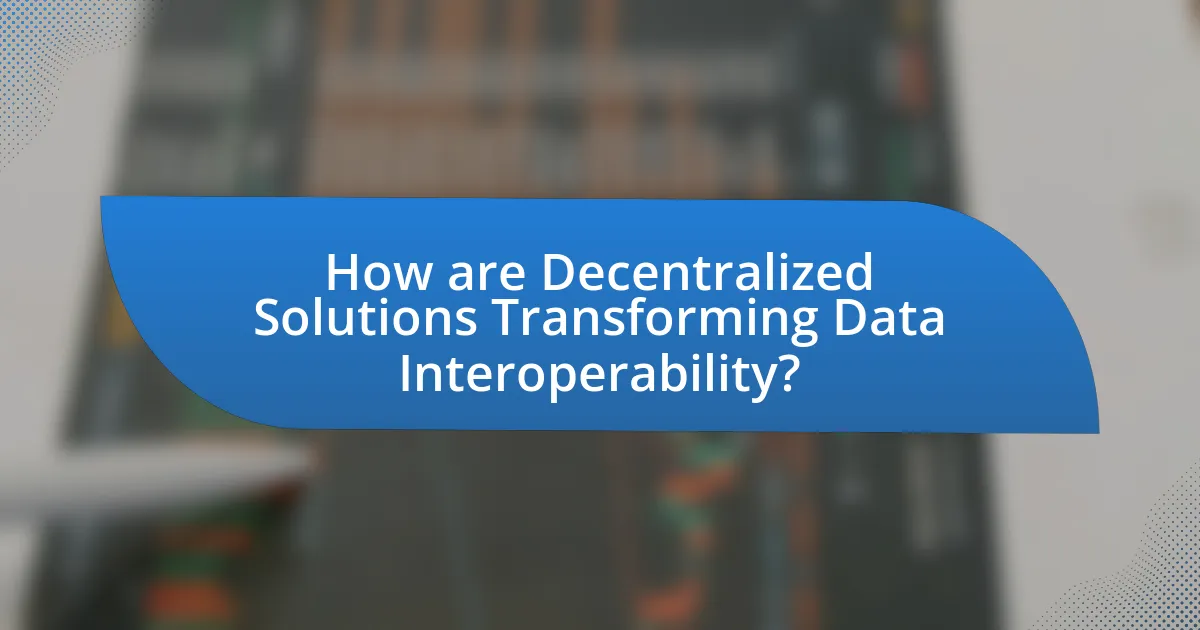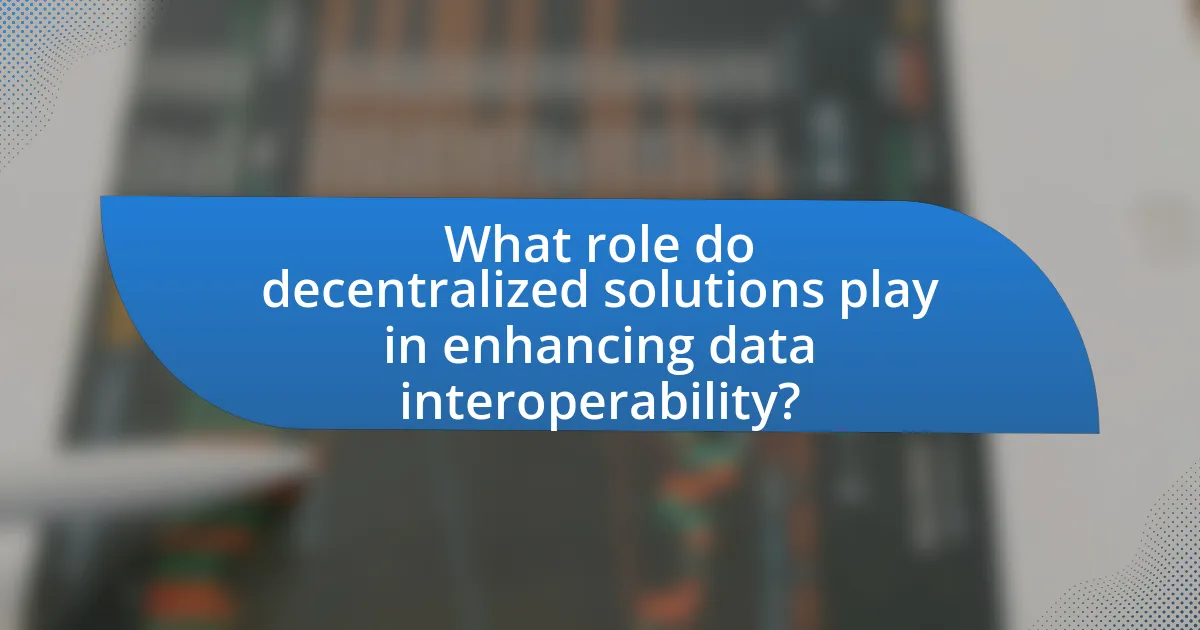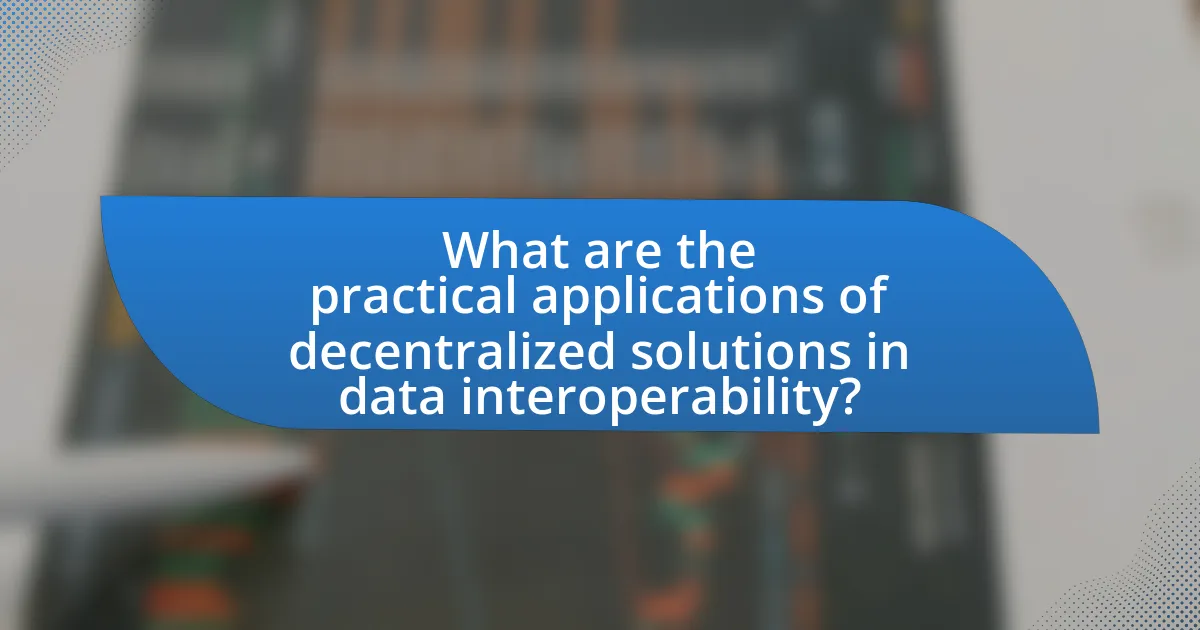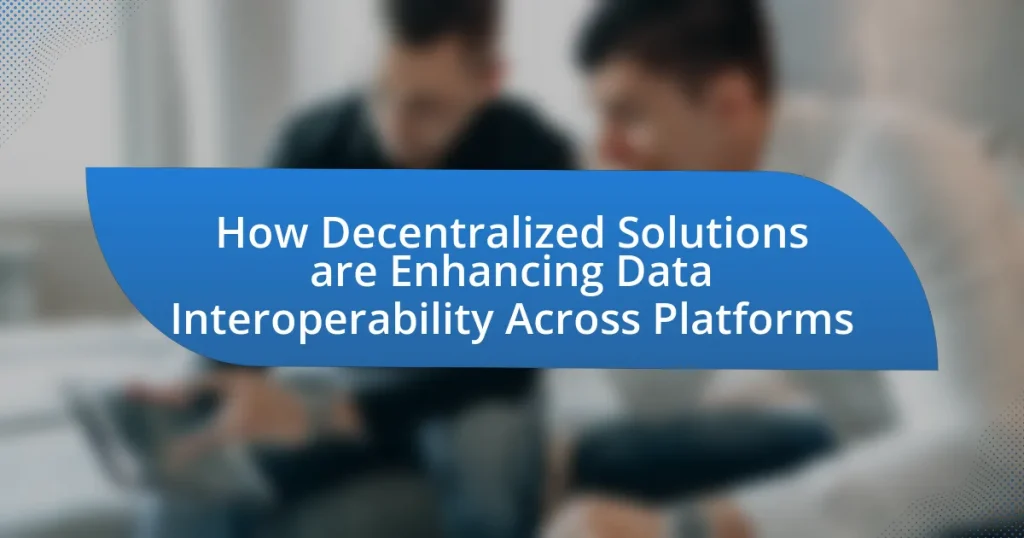Decentralized solutions are revolutionizing data interoperability by facilitating seamless data exchange across various platforms without the need for a central authority. Utilizing blockchain technology and distributed ledgers, these solutions enhance security, transparency, and user control over data. Key principles such as autonomy, transparency, and resilience underpin these systems, distinguishing them from traditional centralized models. The article explores the technologies that support decentralized solutions, the importance of data interoperability, the challenges organizations face, and the practical applications across industries, highlighting successful case studies and best practices for implementation.

How are Decentralized Solutions Transforming Data Interoperability?
Decentralized solutions are transforming data interoperability by enabling seamless data exchange across disparate systems without relying on a central authority. These solutions utilize blockchain technology and distributed ledgers to create a secure and transparent environment where data can be shared in real-time, ensuring that all parties have access to the same information. For instance, projects like the InterPlanetary File System (IPFS) and the Solid project by Tim Berners-Lee demonstrate how decentralized protocols facilitate data sharing while maintaining user control over their data. This transformation is evidenced by the increasing adoption of decentralized identity systems, which allow users to manage their credentials across various platforms, thereby enhancing interoperability and reducing data silos.
What are the key principles of decentralized solutions?
The key principles of decentralized solutions include autonomy, transparency, security, and resilience. Autonomy allows users to control their own data without reliance on a central authority, promoting individual empowerment. Transparency ensures that all transactions and processes are visible and verifiable, fostering trust among participants. Security is enhanced through cryptographic techniques that protect data integrity and privacy, reducing the risk of breaches. Resilience refers to the system’s ability to remain operational despite failures or attacks, as decentralized networks do not have a single point of failure. These principles collectively contribute to the effectiveness of decentralized solutions in enhancing data interoperability across platforms.
How do decentralized solutions differ from traditional systems?
Decentralized solutions differ from traditional systems primarily in their architecture and control mechanisms. Traditional systems typically rely on a centralized authority to manage data and processes, which can create single points of failure and limit transparency. In contrast, decentralized solutions distribute control across multiple nodes, enhancing resilience and reducing the risk of data manipulation. For example, blockchain technology exemplifies decentralization by allowing multiple participants to validate transactions without a central intermediary, thereby increasing trust and security. This structural difference enables decentralized systems to facilitate greater data interoperability across platforms, as they can operate independently while still sharing information seamlessly.
What technologies underpin decentralized solutions?
Decentralized solutions are primarily underpinned by blockchain technology, peer-to-peer networking, and smart contracts. Blockchain technology provides a secure and immutable ledger for transactions, ensuring transparency and trust among participants. Peer-to-peer networking facilitates direct interactions between users without intermediaries, enhancing efficiency and reducing costs. Smart contracts automate processes and enforce agreements without the need for a central authority, further promoting decentralization. These technologies collectively enable secure, transparent, and efficient data interoperability across platforms, as evidenced by the increasing adoption of decentralized finance (DeFi) and decentralized applications (dApps) in various industries.
Why is data interoperability important across platforms?
Data interoperability is crucial across platforms because it enables seamless data exchange and integration, enhancing collaboration and efficiency. When different systems can communicate and share data effectively, organizations can leverage diverse data sources for better decision-making and innovation. For instance, a study by the World Economic Forum highlights that improved data interoperability can lead to a 30% increase in productivity in industries that rely on data-driven insights. This capability is essential for decentralized solutions, as it fosters a more connected ecosystem where data flows freely, supporting real-time analytics and comprehensive insights.
What challenges do organizations face with data interoperability?
Organizations face several challenges with data interoperability, including data silos, varying data standards, and integration complexities. Data silos occur when information is isolated within specific departments or systems, hindering seamless communication and collaboration. Varying data standards arise from different formats and protocols used across platforms, making it difficult to exchange and interpret data accurately. Integration complexities stem from the technical difficulties involved in connecting disparate systems, which can lead to increased costs and extended timelines for implementation. These challenges can significantly impede an organization’s ability to leverage data effectively for decision-making and operational efficiency.
How does improved data interoperability benefit businesses?
Improved data interoperability benefits businesses by enabling seamless data exchange across different systems and platforms. This enhanced connectivity allows organizations to streamline operations, reduce data silos, and improve decision-making processes. For instance, a study by McKinsey found that companies with high data interoperability can achieve up to a 20% increase in productivity due to more efficient workflows and better access to real-time information. Additionally, improved interoperability fosters collaboration among teams and partners, leading to innovative solutions and faster response times to market changes.

What role do decentralized solutions play in enhancing data interoperability?
Decentralized solutions significantly enhance data interoperability by enabling seamless data exchange across diverse platforms without relying on a central authority. These solutions utilize blockchain technology and distributed ledgers, which ensure that data is stored in a tamper-proof manner and can be accessed by multiple parties simultaneously. For instance, projects like the InterPlanetary File System (IPFS) allow for decentralized storage and retrieval of data, facilitating interoperability among applications that require access to the same datasets. Additionally, decentralized identity systems, such as Self-Sovereign Identity (SSI), empower users to control their data, promoting interoperability by allowing different services to verify identities without centralized databases. This approach not only increases efficiency but also enhances security and privacy, as data is not confined to a single point of failure.
How do decentralized solutions facilitate data sharing?
Decentralized solutions facilitate data sharing by enabling peer-to-peer interactions without a central authority, which enhances security and control over data. These solutions utilize blockchain technology and distributed ledgers, allowing users to share data directly with one another while maintaining ownership and privacy. For instance, in healthcare, decentralized platforms enable patients to share their medical records securely with providers, ensuring that data is only accessible to authorized parties. This method reduces the risk of data breaches and fosters trust among users, as evidenced by the increasing adoption of decentralized applications in various sectors, which has been shown to improve data interoperability and streamline processes.
What mechanisms ensure secure data exchange in decentralized systems?
Secure data exchange in decentralized systems is ensured through mechanisms such as cryptographic protocols, consensus algorithms, and decentralized identity management. Cryptographic protocols, including public-key cryptography and hashing, protect data integrity and confidentiality during transmission. Consensus algorithms, like Proof of Work and Proof of Stake, validate transactions across the network, preventing unauthorized access and ensuring data authenticity. Decentralized identity management systems, such as self-sovereign identities, empower users to control their personal data, enhancing privacy and security. These mechanisms collectively create a robust framework for secure data exchange in decentralized environments.
How do decentralized identifiers contribute to interoperability?
Decentralized identifiers (DIDs) enhance interoperability by providing a standardized method for entities to establish their identity across different systems without relying on a central authority. This standardization allows various platforms to recognize and interact with the same identifier, facilitating seamless data exchange and communication. For instance, DIDs are built on blockchain technology, which ensures that the identifiers are tamper-proof and universally accessible, thereby promoting trust and reducing friction in cross-platform interactions. The W3C’s DID specification further supports this by defining a common framework that enables diverse applications to utilize DIDs, ensuring compatibility and fostering a more interconnected digital ecosystem.
What are the limitations of decentralized solutions in data interoperability?
Decentralized solutions in data interoperability face several limitations, including scalability challenges, data consistency issues, and governance complexities. Scalability is hindered as decentralized networks often struggle to handle large volumes of data efficiently, leading to slower transaction speeds and increased latency. Data consistency issues arise because multiple nodes may have different versions of the same data, complicating synchronization and leading to potential discrepancies. Governance complexities stem from the lack of a centralized authority, making it difficult to establish clear protocols and standards for data sharing, which can result in fragmentation and interoperability challenges. These limitations highlight the need for careful design and management of decentralized systems to enhance their effectiveness in data interoperability.
What technical challenges must be overcome for wider adoption?
Wider adoption of decentralized solutions for data interoperability faces several technical challenges, including scalability, security, and standardization. Scalability issues arise as decentralized networks must efficiently handle increasing amounts of data and user transactions without compromising performance; for instance, Ethereum’s network congestion during peak usage highlights this challenge. Security concerns involve protecting sensitive data from breaches and ensuring the integrity of transactions, as evidenced by various high-profile hacks in blockchain systems. Lastly, the lack of standardized protocols across different platforms complicates interoperability, making it difficult for systems to communicate effectively; the absence of universally accepted frameworks has hindered seamless integration. Addressing these challenges is crucial for fostering broader acceptance and utilization of decentralized technologies.
How do regulatory issues impact decentralized data interoperability?
Regulatory issues significantly hinder decentralized data interoperability by imposing compliance requirements that can restrict data sharing and integration across platforms. For instance, regulations such as the General Data Protection Regulation (GDPR) in Europe mandate strict data handling and privacy protocols, which can complicate the seamless exchange of data in decentralized systems. These regulations often require organizations to implement specific data governance frameworks, which may not align with the inherently flexible and open nature of decentralized technologies. Consequently, the need for compliance can lead to fragmented data ecosystems, where interoperability is limited due to varying regulatory interpretations and implementations across jurisdictions.

What are the practical applications of decentralized solutions in data interoperability?
Decentralized solutions in data interoperability enable secure, efficient, and transparent data sharing across various platforms. These applications include blockchain-based identity verification, which allows users to control their personal data while ensuring authenticity; decentralized data marketplaces that facilitate the exchange of data without intermediaries, enhancing privacy and reducing costs; and smart contracts that automate data transactions, ensuring compliance and reducing the risk of errors. For instance, the use of blockchain in healthcare allows for secure sharing of patient records among providers, improving care coordination while maintaining patient privacy.
How are industries leveraging decentralized solutions for data interoperability?
Industries are leveraging decentralized solutions for data interoperability by utilizing blockchain technology and distributed ledgers to enable secure, transparent, and real-time data sharing across platforms. For instance, in supply chain management, companies like IBM and Maersk have implemented blockchain to create a shared, immutable record of transactions, which enhances traceability and reduces discrepancies. This approach allows multiple stakeholders to access and verify data without relying on a central authority, thereby improving collaboration and efficiency. Additionally, decentralized identity solutions, such as those developed by the Sovrin Foundation, facilitate secure data exchange while maintaining user privacy, further promoting interoperability across various sectors.
What case studies illustrate successful implementations?
Case studies illustrating successful implementations of decentralized solutions enhancing data interoperability include the use of blockchain technology in supply chain management by IBM and Maersk. This collaboration, known as TradeLens, has improved transparency and efficiency by allowing all parties in the supply chain to access real-time data, reducing delays and errors. Additionally, the healthcare sector has seen successful implementations, such as the MediLedger Project, which utilizes blockchain to ensure secure and interoperable data sharing among pharmaceutical companies, thereby enhancing traceability and compliance. These examples demonstrate how decentralized solutions can effectively improve data interoperability across various platforms.
How do decentralized solutions enhance collaboration between organizations?
Decentralized solutions enhance collaboration between organizations by enabling secure, transparent, and efficient data sharing without relying on a central authority. These solutions utilize blockchain technology, which allows multiple parties to access and verify data in real-time, fostering trust and reducing the risk of data manipulation. For instance, a study by the World Economic Forum highlights that decentralized platforms can streamline supply chain processes by allowing all stakeholders to track goods and verify transactions independently, thus improving operational efficiency and reducing costs.
What best practices should organizations follow when implementing decentralized solutions?
Organizations should prioritize clear governance structures when implementing decentralized solutions. Establishing defined roles and responsibilities ensures accountability and facilitates decision-making processes. Additionally, organizations should focus on interoperability standards to enable seamless communication between different decentralized systems, which enhances data sharing and collaboration. Regular training and education for stakeholders on decentralized technologies are essential to foster understanding and effective usage. Furthermore, organizations must implement robust security measures to protect data integrity and privacy, as decentralized solutions can be vulnerable to attacks. Finally, organizations should adopt a phased implementation approach, allowing for iterative testing and adjustments based on feedback, which can lead to more successful integration of decentralized solutions.
How can organizations ensure data security and privacy in decentralized systems?
Organizations can ensure data security and privacy in decentralized systems by implementing robust encryption methods, utilizing blockchain technology, and enforcing strict access controls. Encryption protects data at rest and in transit, making it unreadable to unauthorized users. Blockchain technology enhances security through its immutable ledger, which ensures that data cannot be altered without consensus from the network. Additionally, strict access controls limit data access to authorized users only, reducing the risk of data breaches. According to a report by the World Economic Forum, blockchain can reduce data tampering by up to 99%, demonstrating its effectiveness in enhancing data security and privacy.
What strategies can enhance user adoption of decentralized solutions?
To enhance user adoption of decentralized solutions, providing user-friendly interfaces and comprehensive educational resources is essential. User-friendly interfaces simplify interactions with decentralized platforms, making them accessible to a broader audience. For instance, platforms like MetaMask have successfully increased adoption by offering intuitive designs that guide users through complex processes. Additionally, educational resources, such as tutorials and webinars, empower users to understand the benefits and functionalities of decentralized solutions, thereby increasing their confidence in using these technologies. Research indicates that user education significantly correlates with higher adoption rates, as seen in the rise of blockchain technology usage among non-technical users when supported by clear instructional content.


